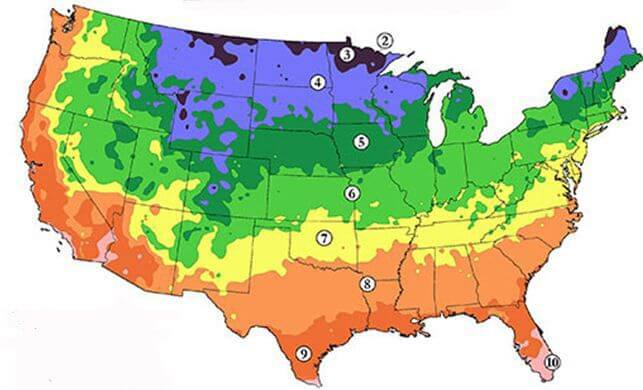FREE Standard Shipping On All Orders $100 or More!*
Landscaping Around Your Inground Pool

After you finish building your own in-ground pool and fill it with water, there is still some work left to do in the backyard. As Larry said when he built his in-ground pool kit this summer, "It looked like a bomb went off in the backyard!"
You may have lost some trees and bushes during your pool construction project, and probably a good bit of turf was torn up. Looking on the bright side, you now have a blank palette to redesign a new backyard paradise!
In this blog post, I'll start with a discussion of some of the worst types of landscaping around a pool, those plants and trees to avoid. Then I'll make some suggestions for trees, plants and ground covers for those pool owners in hardiness Zones 6, 7 and 8.
Plants to Avoid Around a Pool
1. Messy: Trees that shed leaves or needles, bark or seeds, known to have a lot of litter, obviously make it difficult to keep the pool clean. Added organic load also consumes sanitizers and elevates phosphate levels.
2. Fruity: Trees with sweet fruits or bushes with berries can make a real mess on your pool deck, as well as attract flies and bees. Berries in the pool are no fun either and can clog up the works or create stains on the pool floor.
3. Flowery: Flowering plants are nice to look at around a pool, especially if you design with perennials for continuously blooming beds. This can be nice for low plants or small bushes, but for larger plants the debris load can be considerable. Flowering plants need pollination, which attracts bees.
4. Thorny: Roses, cactus or aloes are sometimes used as "security shrubbery" to keep thieves away from windows and doors. Used in a similar way, they can add a "layer of protection" around your pool but can also be painful if your swimmers make contact.
5. Rooty: Invasive root systems. Generally speaking, trees should be kept a good distance from the pool's edge, at least 15 feet. Some trees, such as mulberry, maple or elm, have massive root systems that can damage the shell of your pool.

6. Thirsty: All plants and trees seek water, but some (such as Weeping Willow) do it so aggressively that they can even poke a hole through your pool liner to satisfy their thirst. Best to avoid these water seeking plants.
Aside from these guidelines above, consider landscaping around your pool with plants that can withstand splashing water without wilting. If you have a saltwater pool, you may choose plants that are tolerant of high salt levels in splashout water and in the soil around the pool.
When designing your pool and patio landscaping, remember that some areas need not be plants at all. Areas of river stone or lava rock can add a low-maintenance separation between planting beds. Small wooden platforms, cabanas or fountain/pond areas can break up the landscape and reduce your necessary maintenance.
Speaking of maintenance, don't plant yourself into a corner! Consider the work load of weeding, pruning, raking, fertilizing and watering that will be required. Choose plants and trees that will match your desired level of maintenance.
Also plan on the growth of the backyard. A blue spruce looks great when you load into the trunk of your car, but 10 years later, it's 50 feet tall, dropping buckets of needles and blocking the sun.
What's Your Zone?

The zone map above helps gardeners determine which plants will do best in their region. Choose plants that are native to your zone or region for best results. This map is sometimes called a hardiness map, as growers will use it to describe their plants. For example, "Hardy in Zones 7 through 10," means you should not use that plant in Zones 3 through 6. Or, "Hardy through Zone 7" means that it's not suited for the warmer climates of Zones 8, 9 or 10.
Here's some of my favorite plants around a pool in Zones 6, 7 and 8. For the hotter or colder zones, follow my outline below. A few Google searches and you can make your own list quickly.
Zone 6:
Trees: Chinese Windmill Palm, Southern Magnolia, American Arborvitae Bushes: Needle Palm, Boxwood Winter Gem, Butterfly Bush Ground Covers: Monkey Grass, Hydrangea, Day Lilies



Zone 7:
Trees: Rice Paper Plant, Crape Myrtle, Leland Cypress Bushes: Banana Leaf, Sage, Gold Thread Cypress Ground Covers: Hosta, Pachysandra, Pampas Grass



Zone 8:
Trees: Cabbage Palm, Blue Sapphire Cypress, Silver Dollar Eucalyptus Bushes: Elephant Ear, Oleander, Japanese Maple Ground Covers: Zinnias, Fountain Grass, Purple Heart



One other tip: Don't be afraid to change things around if they don't work out. Ten years from now, if a 50-foot Blue Spruce is blocking your tanning hour, or you find certain plants and bushes to be too much work, or if some never really took root, or turned out ugly, start over. Cut it down, clean it up, and bring home something else in the trunk of your car!